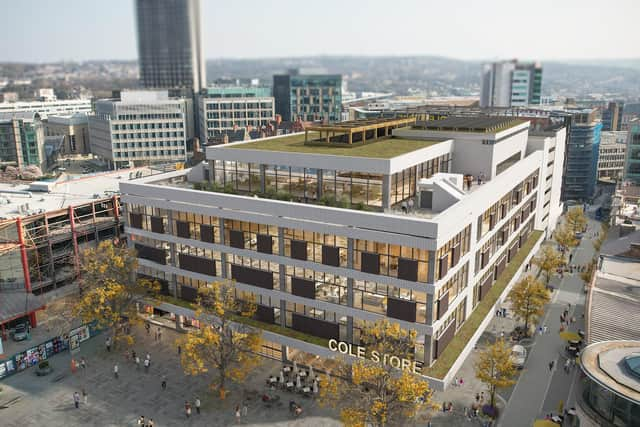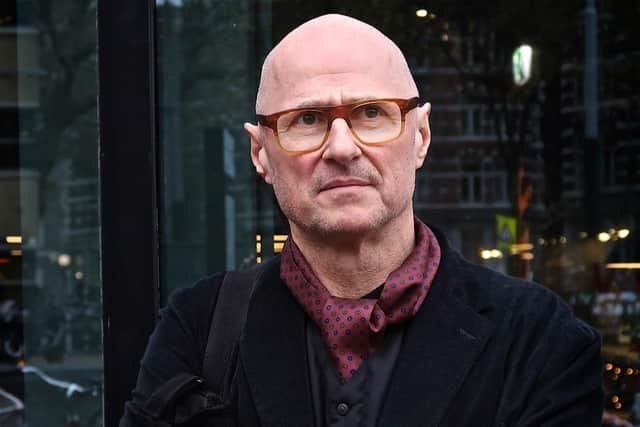Cole Brothers: Son of man who designed iconic Sheffield department store is reinventing it 60 years on
His father David came from humble roots in Sheffield but was something of an architectural prodigy. At the age of just 27, he was tasked with designing Gatwick Airport and his other projects included St Thomas’ Hospital in London and Warwick University.
Another of his schemes was the creation of a Cole Brothers department store in his home city, which opened in 1963. It was turned into John Lewis in 2002 but when the retailer announced its plans to shut the store in 2021, the strength of local feeling was so great that almost 25,000 people signed a petition pleading for a rethink.
Advertisement
Hide AdAdvertisement
Hide AdBut the closure went ahead and since then, the building has stood empty while a debate has raged about its future.


Now Simon’s firm Allford Hall Monaghan Morris and its development partner Urban Splash have been selected by Sheffield Council to repurpose the five-storey site. They have unveiled plans to turnit into a mixed-use combination of offices and independent shops, bars and restaurants that will be used by thousands of people on a daily basis.
Allford says that being involved in giving new life to a building designed by his father is filled with emotion. “My father gave me two great afflictions,” he says with a smile as he talks to The Yorkshire Post on a video call from his London office. “One is to be an architect and the other is to follow Sheffield Wednesday.”
But while Allford was never shy about the family connection to the Owls – his own three daughters now all have Wednesday as their shared middle name – for years he was more circumspect about his architectural link.
Advertisement
Hide AdAdvertisement
Hide AdAllford has built his own successful career and is now president of RIBA but as he was starting out in the architectural world, he was determined to make his own way.


Even when London-raised Allford decided to study architecture at Sheffield University, he kept quiet about his eminent father and his connection to Cole Brothers. “I never said anything to anyone about him or his connections in modern architecture. I kept well away from that,” he says. “Allford is not that a common a name so people would make the connection and ask if we were related. I used to joke, ‘Only distantly’, but would if they asked say he was my old man.
“As a young architect, although I got on well with my father, I steered a million miles away from him professionally. As much as I liked him, I didn’t want to be known just as ‘his son’. I set up my own business with my own team but he was a great adviser and mentor to all us.
“But he died in 1997 which was seven years after we were formed. Obviously with time and distance grows fondness so I’m now happy to see links between what I was doing and what he was doing.”
Advertisement
Hide AdAdvertisement
Hide AdIn common with Warwick University and St Thomas’ Hospital, Cole Brothers was one of David Allford’s “white tile projects” building on a key architectural style of the time.
His son says: “They were basically rebuilding a brave new world, post-war. There’s an image of Cole Brothers when the whole of Sheffield is black and covered in soot as an industrial city and then Cole Brothers was this white-tiled sculpture landing opposite the City Hall.
“There was a very powerful relationship with the hall opposite – it forms this kind of civic relationship of commerce and culture. It gave that part of Sheffield a civic context, which is obviously what we’re trying to build on.”
Allford says he approached Urban Splash – which is overseeing the redevelopment of Park Hill Flats in Sheffield – about working together on a joint bid to redesign the building after it the vacant site was given listed status.
Advertisement
Hide AdAdvertisement
Hide Ad“I said to them, ‘This project is coming up and it would be a fabulous chance for me to re-engage with my father’s project, with Sheffield and for you, with Park Hill entering its final chapter to pick up another project in the city which has a different relationship with the city.
“Initially, I think they questioned whether it was the right time for them to do another project in Sheffield. But they fell in love with the generosity and scale of the building.”
He says their scheme views the building as an “urban palazzo”, whose regeneration can tie with the Heart of the City project to reimagine Sheffield city centre as a place for much more than just shopping.
“On the main building site, we are proposing where the escalators are to cut a hole to let light in. We will end up getting three floors of work space and maybe in due course another floor on the roof. You create a private-public building on the office side and a more public building on the car park side.
Advertisement
Hide AdAdvertisement
Hide Ad“You can create retail uses in different forms like restaurants and bars at ground level that will complement music venues and other things coming forward.
“There are amazing lower ground and basement spaces that could become venues and other things. Because of Sheffield being on seven hills and the natural slopes, you can bring people in at different levels. We’re proposing the service bay becomes the entrance to the offices.”
“It will become a journey of discovery with the planners and the city about what works best and what people want.”
Allford says it is hoped initial pop-up events can be staged on the site in the relatively near future as the longer-term proposals go through a consultation stage, with planning permission then being sought.
Advertisement
Hide AdAdvertisement
Hide Ad“It’s an iconic building for the city and we want people to engage with it. The idea of doing pop-ups, whatever they are, means the building doesn’t get mothballed, it comes back to life and people get used to thinking about it.
“But we also get feedback whether it is a pop-up restaurant or arts event, they will be consultation and feedback sessions themselves. There isn’t a clear brief but there’s an amazing building which can do things. It is a vessel into which uses will be poured.
“If we’ve got the fundamentals of the project right, the bits in between can be occupied differently according to need over a long period of time, which is what a good building does.
“Success would be the idea that 2,000 to 3,000 people are using the building and it is probably working 18 hours a day, dawn until dusk, for multiple purposes.
Advertisement
Hide AdAdvertisement
Hide Ad“People are working there, doing leisure activities there, shopping there. The roof is amazing and the building has lots of structural capacity.
“I think we can extend it in due course in an appropriate way. But initially, just imagine bringing that roof into play as a social space for the city.
“If the project is 18 months of planning and two or three years of development, that’s a long way off if nothing happens in between.”
Allford may have resisted following too closely in his father’s footsteps as he forged his own career, but says he is now embracing the chance to build on his legacy.
Advertisement
Hide AdAdvertisement
Hide Ad“It is great completing of the turn of the circle. There’s something quite nice that after all these years I’m involved with reinvigorating this building. I’m happy to say I’m his son, working on the building with others, to bring it back to a newly-reinvented life.
“It’s a poetic moment. I’m excited by all projects but this one has a lovely personal turn of the wheel.”